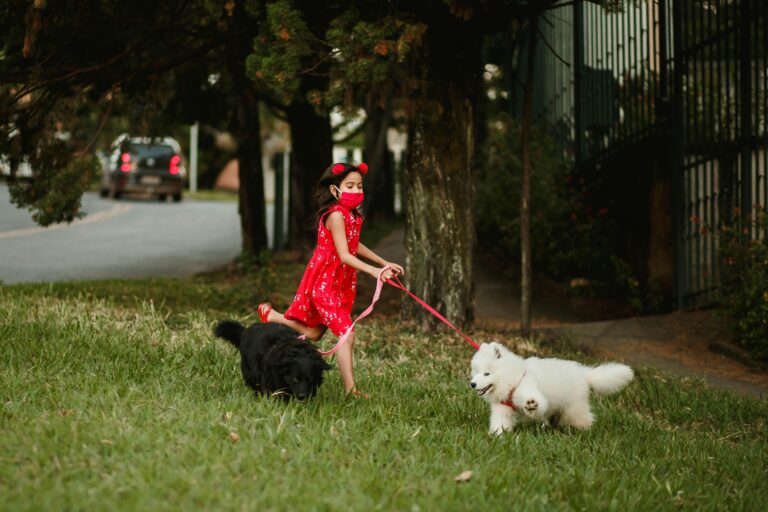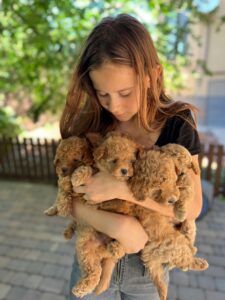Bringing Balance to a Busy Home: Kids and Dogs Can Be a Dream Team
There’s nothing quite like watching your child grow up with a loyal dog by their side. But let’s be honest, combining kids and dogs under one roof can sometimes feel chaotic. Between school schedules, playtime, and busy family routines, it’s easy to miss the cues that your dog might be overwhelmed or your child might be unintentionally reinforcing bad habits.
As a professional dog trainer, I’ve seen how transformative it can be when families take a structured approach to training. The key isn’t just about obedience. It’s about communication, consistency, and creating positive experiences for both two-legged and four-legged family members.
Let’s walk through the essential training tips every family should know to create a safe, happy, and respectful home for both kids and dogs.
Start With Boundaries, Not Commands
Before you teach your dog to “sit” or “stay,” establish clear household boundaries. Dogs thrive when they understand the rules. Are they allowed on the couch? What’s the feeding routine? Who handles walks?
Teach Kids to Respect These Rules Too:
- No pulling tails or ears
- No interrupting a dog during rest, mealtime, or crate time
- Use calm voices and gentle touches
Creating boundaries helps your dog feel safe and teaches children to interact with animals respectfully.
Use Basic Commands to Build Mutual Respect
The most effective foundation for any household, especially with children, is Basic Obedience Training. This teaches your dog to respond to key commands like “come,” “place,” and “leave it,” which are vital in a home full of distractions.
When your dog has solid obedience skills, your child can participate in supervised training sessions, reinforcing positive behaviors through games and consistency.
Explore our Basic Obedience Program to see how we can help your dog master the commands that matter most in a family setting.
Make Training a Family Affair
Training doesn’t have to be a chore. In fact, it works best when everyone gets involved.
Try these fun, family-friendly training routines:
- “Place” Relay: Have your child point to a dog bed or mat and say “place,” then reward your pup for going there.
- “Hide & Seek Recall”: One family member hides while the dog practices the “come” command to find them.
- “Treat Toss for Focus”: Practice eye contact before tossing treats. This helps with impulse control.
These low-stress games are great for reinforcing your dog’s training while teaching kids how to work with your pup safely.
For more at-home enrichment ideas, check out our guide on keeping your dog active when it’s too hot outside. It’s packed with kid-friendly activities that double as training exercises.
Supervision Isn’t Optional. It’s Essential
No matter how well-behaved your dog is, never leave young kids and dogs alone unsupervised. Even gentle pups can get startled or overwhelmed.
Key safety practices:
- Use baby gates to create separation when needed
- Teach children to respect a dog’s crate as their safe space
- Interrupt rough or overexcited play immediately
Your job is to advocate for your dog’s comfort while also keeping your child safe.
Understand the Dog’s Body Language
Kids may not always recognize when a dog is feeling anxious or overstimulated. That’s why it’s crucial for parents to learn canine body language and teach their kids what to look for.
Watch for signs of stress in your dog:
- Lip licking or yawning
- Whale eye (seeing the whites of their eyes)
- Ears pinned back or tail tucked
- Avoidance behaviors like turning away or walking off
Empowering your children to read the room can prevent accidents and build lasting trust.
Consistency Is King
Dogs and kids both thrive on routine. Your dog should receive the same cues and expectations from every member of the household. Inconsistent training confuses dogs and undermines progress.
To stay consistent:
- Use the same commands across the board
- Reinforce behaviors positively and promptly
- Avoid yelling or punishing. Instead, redirect calmly
Families that train together build stronger bonds and clearer communication.
What About When Things Get Out of Hand?
If your dog is showing signs of anxiety, aggression, or fear around children, don’t try to handle it alone. These issues can escalate quickly without professional guidance.
At Off Leash K9 Training West Virginia, we specialize in behavior modification and family-focused training that addresses real-life challenges with tailored solutions. Whether your dog needs help with jumping, reactivity, or overstimulation, we’re here to help you regain balance.
You can also review this helpful guide from the AKC on 4 ways to teach kids and dogs to play together. It’s a solid foundation for fun and safe bonding.
Checklist Review: Kid-Friendly Training Habits
- Kids know basic dog safety rules
- Dog has a quiet space to retreat to
- Family members use consistent commands
- Training is built into playtime
- Dog and child interactions are supervised
- Everyone practices positive reinforcement
Training Makes the Difference in Family Harmony
When kids and dogs learn together, the results are more than just good behavior. They’re lifelong friendships built on respect and trust. With the right tools and consistency, you can create a home where your dog listens, your kids understand, and everyone feels safe and happy.
If you’re ready to take that next step toward a more balanced household, contact us today. Our experienced team is here to support your family every step of the way.
Reach out to schedule a consultation today. Let’s build a better bond between your dog and your entire family.
Social Media Teaser:
Got kids and dogs under one roof? Discover how to create peace, structure, and better behavior with these family-friendly dog training tips!


